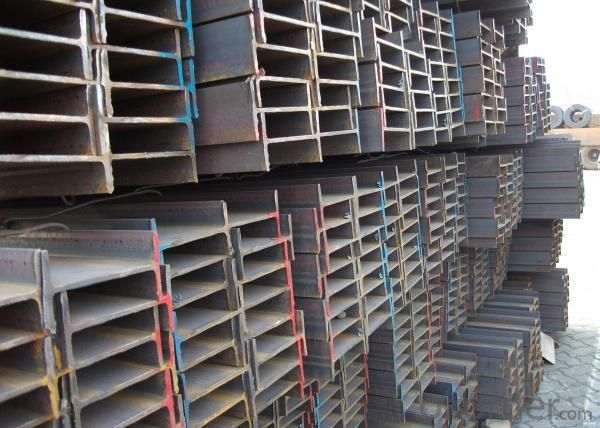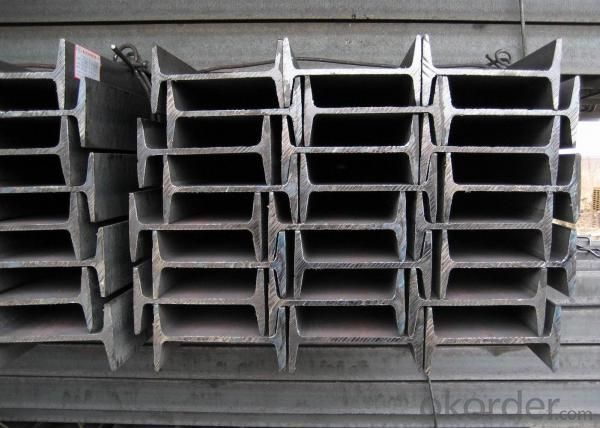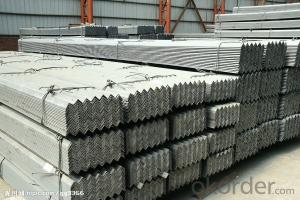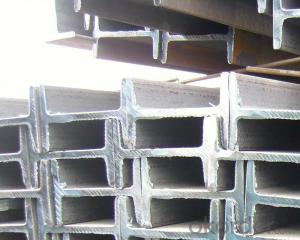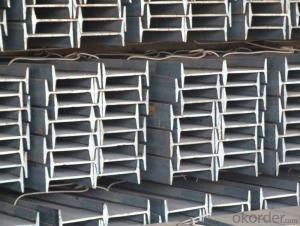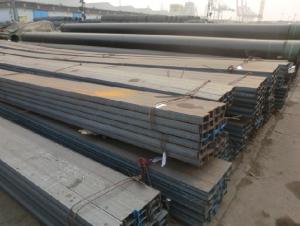Steel I-Beams
- Loading Port:
- Tianjin Port
- Payment Terms:
- TT or LC
- Min Order Qty:
- 25Mt m.t.
- Supply Capability:
- 10000Mt m.t./month
OKorder Service Pledge
OKorder Financial Service
You Might Also Like
Specifications of Steel I-Beams
1. Invoicing on theoretical weight or actual weight as customer request
2. Length: 5.8m, 6m, 9m, 12m as following table
3. Sizes of Steel I-Beams: 80mm-270mm
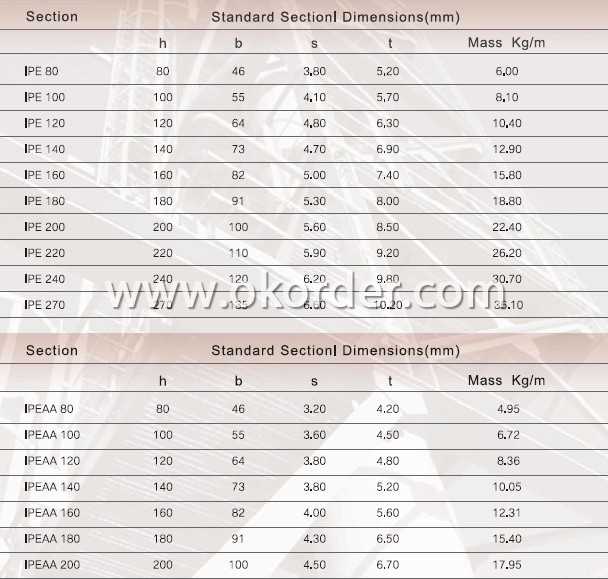
Dimensional Specifications of Steel I-Beams: EN10025, ASTM, GB Standard, JIS, etc.
Material Specifications of Steel I-Beams: EN10025, S235JR, GB Q235B or Equivalent
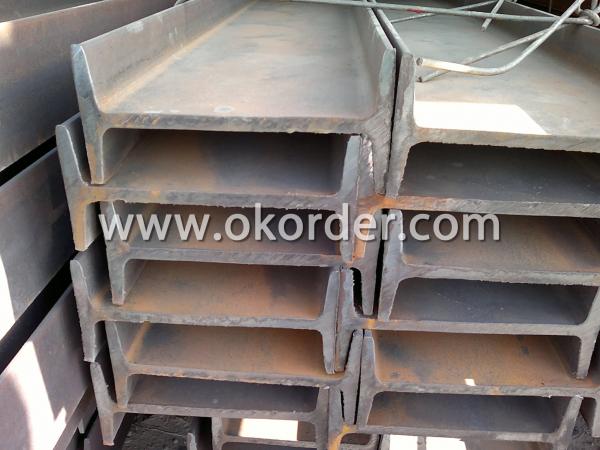
Applications of Steel I-Beams
Commercial building structure
Pre-engineered buildings
Machinery support structures
Prefabricated structure
Medium scale bridges
Package & Delivery of Steel I-Beams
1. Package: All the products are packed in bundles and tied by steel wire rod then put into containers or in bulk cargo. Each bundle of I-Beam will be hung with the markings of CNBM or as the requriements of the customer. Each bundle contains about 50 pieces.
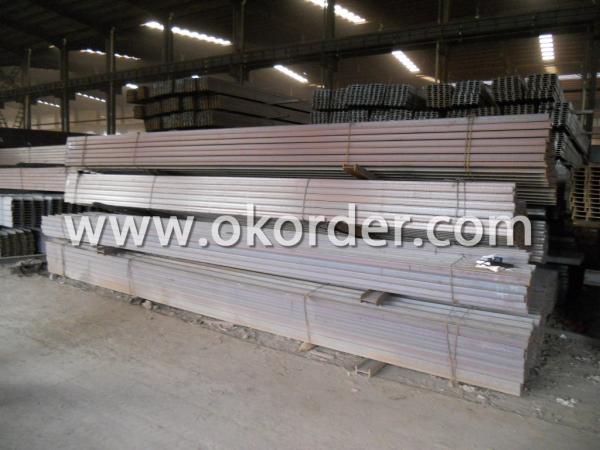
2.Tag mark: there will be tag mark tied up on the bundles. The information usually including supplier logo and name, product name, made in China, shipping marks and other information request by the customer.
If loading by container the marking is not needed, but we will prepare it as customer request.
3. Delivery: The Steel I-Beams will be delivered to the loading port in 45 days after receiving your advance payment or the original L/C at sight.
4. Transportation: the goods are delivered by truck from mill to loading port, the maximum quantity can be loaded is around 40MTs by each truck. If the order quantity cannot reach the full truck loaded, the transportation cost per ton will be little higher than full load.
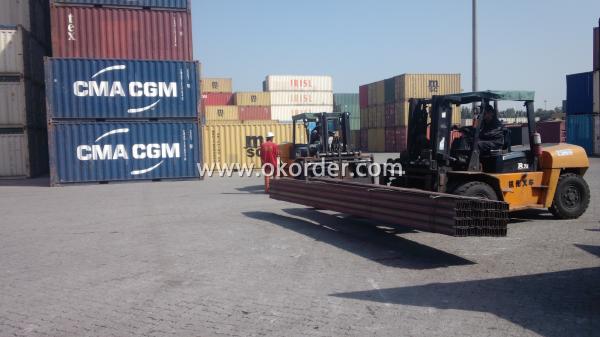
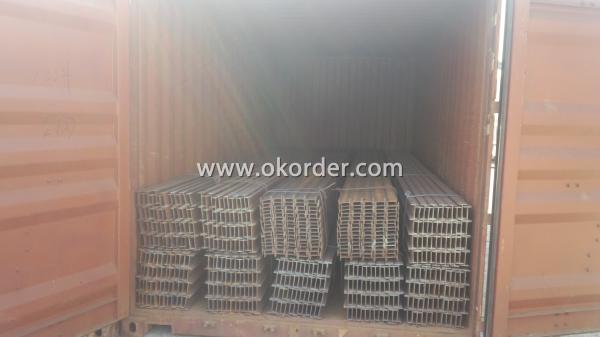
- Q: Can steel I-beams be used for residential construction?
- Certainly! Residential construction can indeed utilize steel I-beams. Their strength, durability, and versatility render steel I-beams widely employed in this field. They frequently serve as load-bearing components in constructing floors, walls, and roofs. Steel I-beams offer exceptional structural support and have the capacity to span considerable distances, thereby enabling the creation of more spacious floor layouts and flexible design alternatives. Moreover, steel possesses non-combustible properties and displays resistance against rot, pests, and weathering, which contributes to its popularity in residential construction.
- Q: Are steel I-beams resistant to chemical exposure?
- Chemical exposure is generally not a concern for steel I-beams. Steel, known for its durability and versatility, is highly resistant to various elements, including chemicals. However, the level of resistance can vary depending on the specific chemical and its concentration. In everyday environments, such as water, air, and mild acids or alkalis, steel I-beams are resilient and can withstand exposure. They can handle moisture without corroding or degrading, making them suitable for construction, infrastructure, and industrial applications. However, highly corrosive chemicals or aggressive substances may affect steel I-beams to some extent. Strong acids, alkaline solutions, or corrosive materials with high concentrations can gradually deteriorate the steel surface, potentially weakening its structure over time. To enhance the resistance of steel I-beams in such conditions, it is important to consider the specific chemical environment and consult experts or engineers for additional protective measures, like coatings or barriers. In conclusion, while steel I-beams inherently resist chemical exposure, it is crucial to assess the specific chemical environment and take appropriate measures to ensure their long-term durability and performance.
- Q: What is the maximum load capacity of a steel I-beam?
- The maximum load capacity of a steel I-beam can vary depending on various factors such as the dimensions of the beam, the type of steel used, and the specific application. It is essential to consult engineering specifications, load charts, and professional guidance to determine the precise maximum load capacity for a particular steel I-beam.
- Q: What are the different types of steel finishes available for steel I-beams?
- Steel I-beams come in several different types of finishes, each with its own advantages and appearance. The most common finishes for I-beams are as follows: 1. Mill finish: This is the standard finish straight from the mill, with a rough and unfinished surface. It is typically gray and is suitable for applications where appearance is not a priority. Mill finish is often used in structural applications where the steel will be covered or painted. 2. Hot-dip galvanized: To achieve this finish, the steel I-beam is immersed in molten zinc, creating a protective coating that prevents corrosion. Hot-dip galvanized steel I-beams are durable, long-lasting, and ideal for outdoor applications, as they can withstand harsh weather conditions and exposure to chemicals. 3. Powder coated: This finish involves applying a dry powder to the steel I-beam, which is then heated and cured to create a durable and smooth finish. Powder coated steel I-beams are available in various colors and offer excellent resistance to corrosion, abrasion, and chemicals. This finish is often used in architectural and decorative applications, where aesthetics are important. 4. Painted: Steel I-beams can also be painted with different types of paint, such as epoxy, enamel, or acrylic. Painting provides an extra layer of protection against corrosion and can enhance the appearance of the steel. Painted finishes are commonly seen in indoor applications, such as commercial buildings or residential structures. 5. Stainless steel: Stainless steel I-beams provide a unique finish that is resistant to corrosion, staining, and rust. This type of steel finish is commonly used in environments where hygiene and cleanliness are crucial, such as food processing plants, hospitals, or pharmaceutical facilities. When selecting the appropriate steel finish for I-beams, it is important to consider the specific requirements of your project, including the intended use, environment, and aesthetic preferences. Consulting with a steel supplier or engineer can help ensure that you choose the right finish for your application.
- Q: Are steel I-beams resistant to pests and insects?
- Yes, steel I-beams are highly resistant to pests and insects as they are made of solid steel which does not attract or provide a suitable environment for pests or insects to nest or feed on.
- Q: Can steel I-beams be used in both residential and commercial buildings?
- Yes, steel I-beams can be used in both residential and commercial buildings. Steel I-beams are commonly used as structural supports due to their strength, durability, and versatility. They provide excellent load-bearing capabilities, allowing for the construction of large spans and open floor plans. In residential buildings, steel I-beams are often used to support the weight of upper floors and roof structures. In commercial buildings, they are frequently employed in the construction of warehouses, factories, and high-rise buildings. The use of steel I-beams ensures the structural integrity of the building, making them suitable for various applications in both residential and commercial settings.
- Q: Are steel I-beams affected by vibrations?
- The impact of vibrations on steel I-beams varies depending on different factors. Vibrations can cause the I-beams to resonate, leading to increased stress and potential damage. The susceptibility of the I-beams to vibration-induced effects is determined by factors such as the magnitude and frequency of the vibrations, as well as the structural design and connections. Under normal conditions, steel I-beams can withstand vibrations without significant consequences. However, excessive or prolonged vibrations can weaken the beams over time, especially if they are high-frequency vibrations caused by heavy machinery or nearby traffic. To mitigate the effects of vibrations, engineers use various strategies. These include incorporating damping systems, such as tuned mass dampers or viscoelastic materials, to absorb and dissipate vibrations. Proper design and construction techniques, such as adequate bracing and connection detailing, also enhance the beams' resistance to vibrations. It is important to consider that vibrations can also be induced by external factors, such as earthquakes or nearby construction activities. The severity of the vibrations and their impact on I-beams depend on the magnitude and proximity of the external force. In conclusion, while steel I-beams are generally resistant to vibrations, excessive or prolonged vibrations can affect their structural integrity. Engineers employ various techniques to mitigate these effects and ensure the stability of I-beams in vibrating environments.
- Q: Can steel I-beams be used for overhead garage doors?
- No, steel I-beams cannot be used for overhead garage doors. Steel I-beams are typically used for structural support in buildings and are not designed to support the weight and movement of a garage door. Overhead garage doors require specialized tracks and springs to properly function, and using steel I-beams in place of these components would compromise the safety and functionality of the door. It is essential to follow the manufacturer's specifications and guidelines when installing or repairing garage doors to ensure proper operation.
- Q: Span 6 meters, with 160 I-beam can bear much weight?
- 16# I-beam 160 x 88 * 6 * 9.9. It weighs 20.5kg per meter. The section moment of Wx = 140900mm. Fand P. load was P = 215 * 140900 * 4 / 6000 = 20196 (N) (KN = 20.2).Answer: able to carry 20.2KN. (including the weight of the steel beam)
- Q: Cantilever scaffold of the I-beam, in the Yang Kok position encountered a frame column, what should I do?
- Through the column, but that you also don't take root I-beam out, the scaffolding removed after directly cut off, make a good corrosion on the inside.
1. Manufacturer Overview
| Location | Tangshan, China |
| Year Established | 2009 |
| Annual Output Value | Above US$ 230 Million |
| Main Markets | Mid East; Southeast Asia; Korea |
| Company Certifications | ISO 9001:2008; |
2. Manufacturer Certificates
| a) Certification Name | |
| Range | |
| Reference | |
| Validity Period |
3. Manufacturer Capability
| a) Trade Capacity | |
| Nearest Port | Tianjin; |
| Export Percentage | 81% - 90% |
| No.of Employees in Trade Department | 21-50 People |
| Language Spoken: | English; Chinese; |
| b) Factory Information | |
| Factory Size: | Above 500,000 square meters |
| No. of Production Lines | 1 |
| Contract Manufacturing | OEM Service Offered; |
| Product Price Range | Average |
Send your message to us
Steel I-Beams
- Loading Port:
- Tianjin Port
- Payment Terms:
- TT or LC
- Min Order Qty:
- 25Mt m.t.
- Supply Capability:
- 10000Mt m.t./month
OKorder Service Pledge
OKorder Financial Service
Similar products
Hot products
Hot Searches
Related keywords



